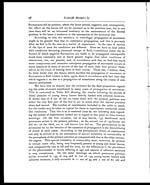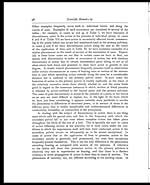Medicine - Institutions > Army health reports and medical documents > Scientific memoirs by medical officers of the Army of India > Part III, 1887 > 9 - On the phemonena of propagation of movement in Mimosa Pudica
(103) Page 97
Download files
Individual page:
Thumbnail gallery: Grid view | List view

Medical Officers of the Army of India.
97
dry leaves. There is, however, nothing to show us that any such special
irritability or contractility in the protoplasm of the main pulvinus exists at all
or is specially related toage and moisture of the leaves.
When we come to consider the other theory we find that it can afford an
explanation both of the occurrence of premature pulvinar action generally and
of the greater tendency to such action in young and moist leaves than in old
and dry ones. The primary pulvinus has more to contend against in maintain-
ing the expanded condition than any other part of the leaf. The masses of
tissue in it determining erection of the leaf have not merely to overcome the
opposing thrust of those favouring depression, but have to overcome the down-
ward leverage of the heavy pinnæ situated at the distal extremity of the long
petiole. In the case of the secondary pulvini, which deal with lateral movements
mainly, the resistance to be overcome is merely that of the opposed masses of
tissue, in that of the tertiary pulvini, the action of the masses of tissue favouring
expansion is aided by, not opposed to, the action of gravity. But under these
circumstances the primary pulvinus must, under certain conditions, be liable to
be affected by negative fluctuations in fluid tension incapable of giving rise to
conspicuous effects elsewhere; or, in other words, the primary pulvinus, under
certain conditions, is adapted to play the part of the most sensitive registering
apparatus of the occurrence of fluctuations in the fluid tension of the tissues.
Any conditions under which the thrust of the depressant pulvinar tissues is
relatively excessive or the weight of the pinnæ abnormally great must tend to
increase the sensitiveness of the apparatus. But in young and moist leaves
such conditions are present in high degree. In the leaves of Mimosa pudica
the tissue of the under-half of the pulvinus is relatively weakest when the leaves
are young and becomes gradually stronger and more resistant with increasing
age. So much is this the case in certain instances that it is not uncommon to
meet with old but otherwise healthy leaves in which the primary pulvinus
is rigid and petiolar depression accordingly impossible. This gradual increase
in relative strength in the structurally weaker masses of pulvinar tissue is not
peculiar to Mimosa pudica. Much more conspicuous examples of it are
afforded by other plants, such as various species of Bauhinia and by Albizzia
Lebbek, in which the young leaves exhibit highly-developed nyctitropic move-
ments, which gradually diminish and ultimately absolutely disappear with
increasing age and thickening and rigidity of the primarily passively weaker
portions of the pulvinar tissues. The existence of such a change in the relative
strength of the opposed masses of tissue accounts, then, for the greater preva-
lence of premature pulvinar movement in old than in young leaves, and the
action of adherent moisture in increasing leverage accounts for its greater
prevalence in wet than in dry ones.
The phenomenon of premature pulvinar action is not the only instance of
discontinuity in propagation of movement presenting itself to observation.
O
Set display mode to: Large image | Zoom image | Transcription
Images and transcriptions on this page, including medium image downloads, may be used under the Creative Commons Attribution 4.0 International Licence unless otherwise stated. ![]()
| Permanent URL | https://digital.nls.uk/75004315 |
|---|
| Shelfmark | IP/QB.10 |
|---|---|
| Additional NLS resources: | |




